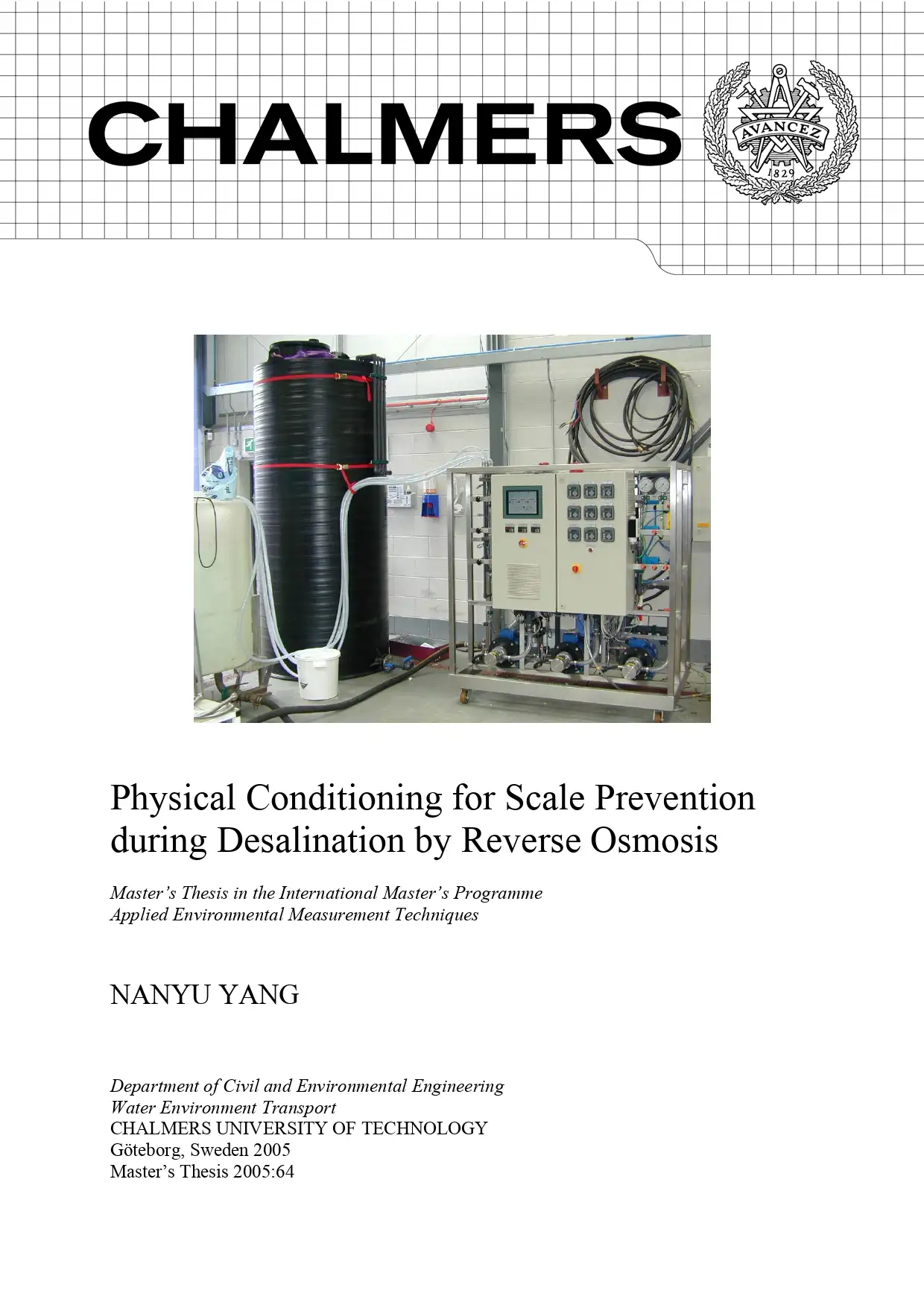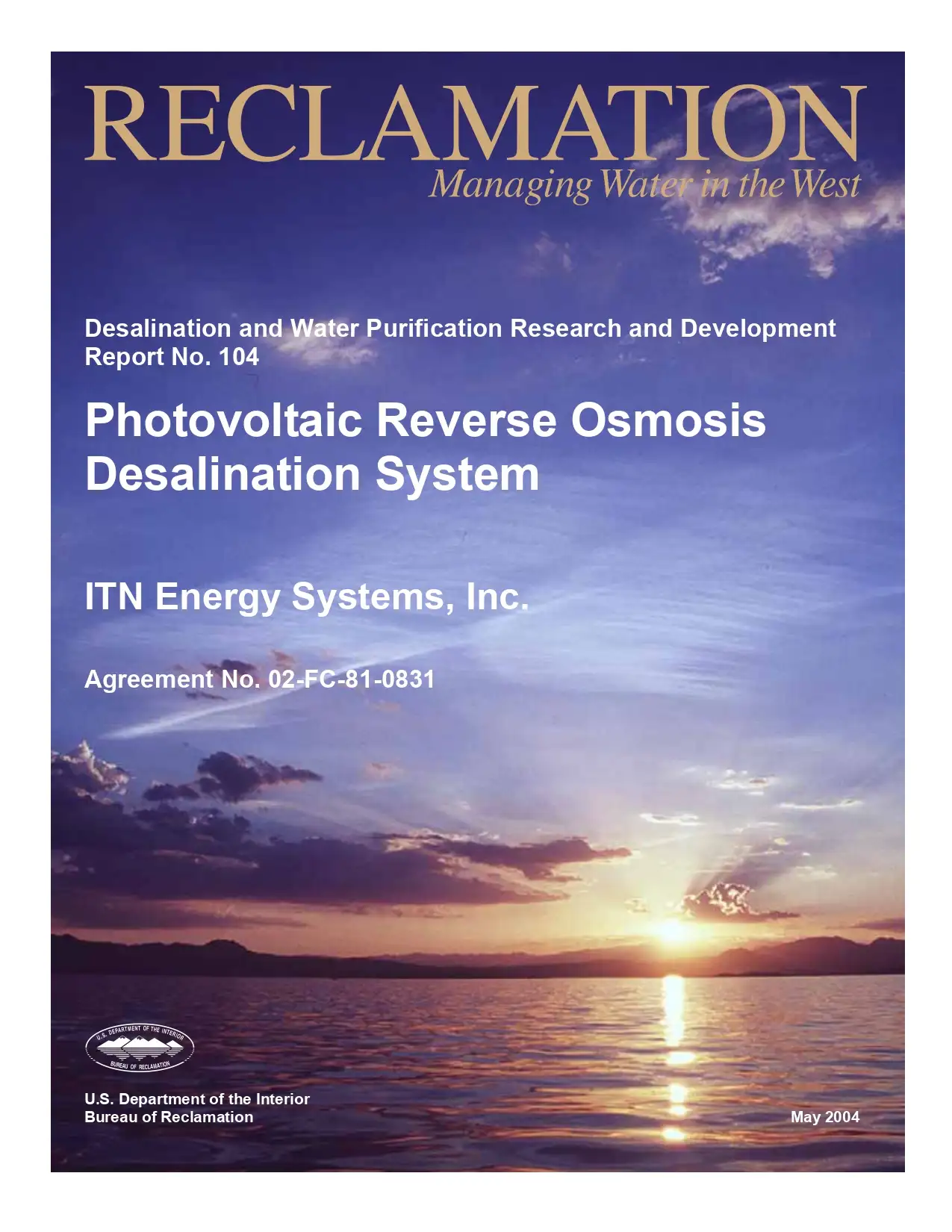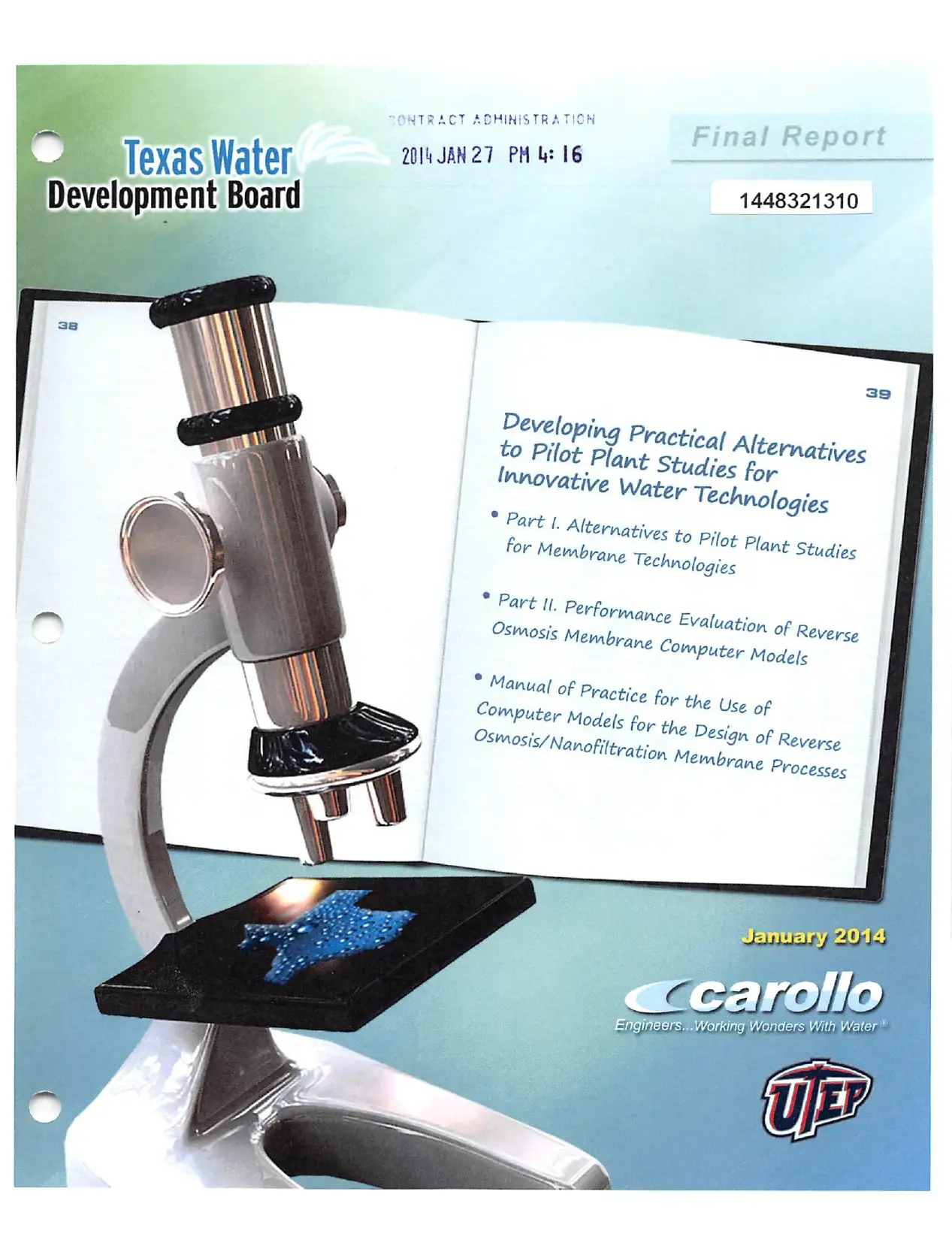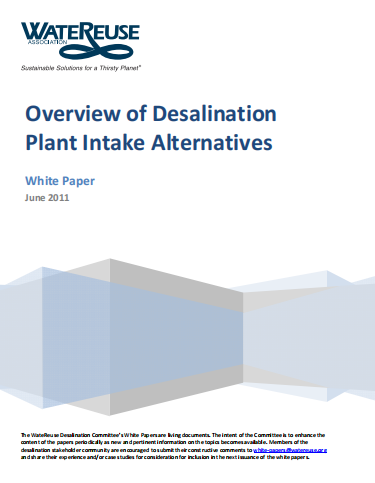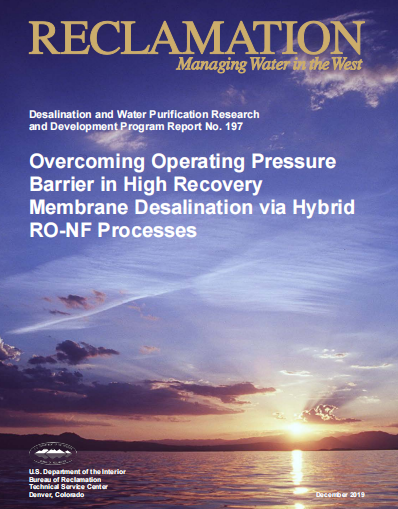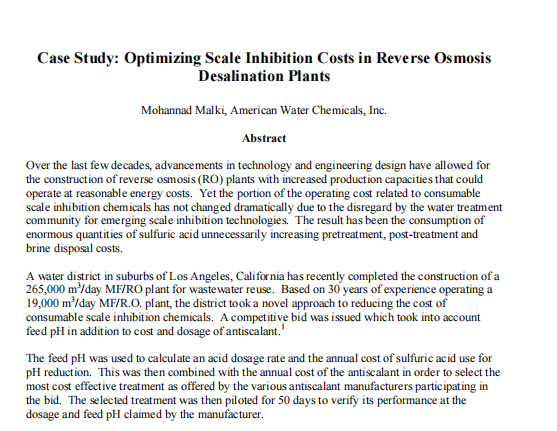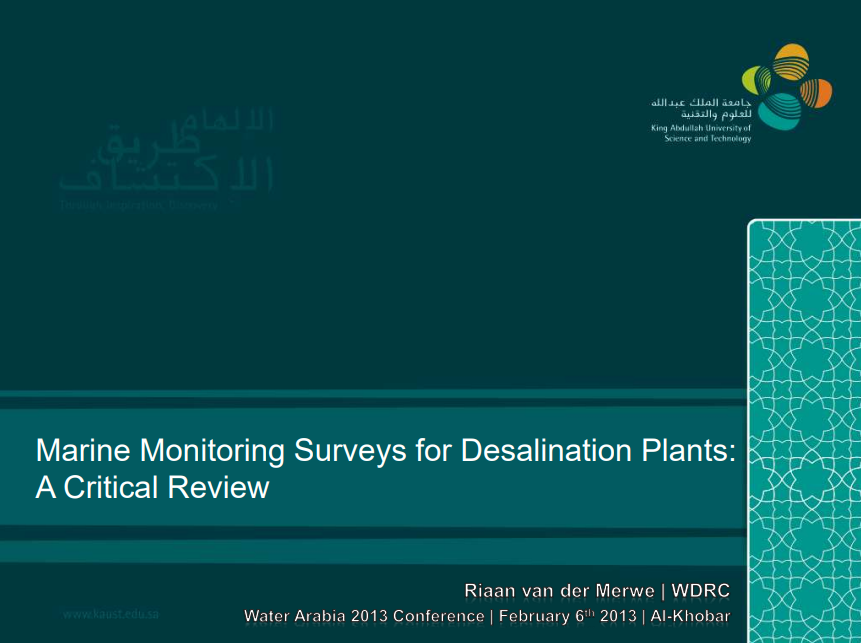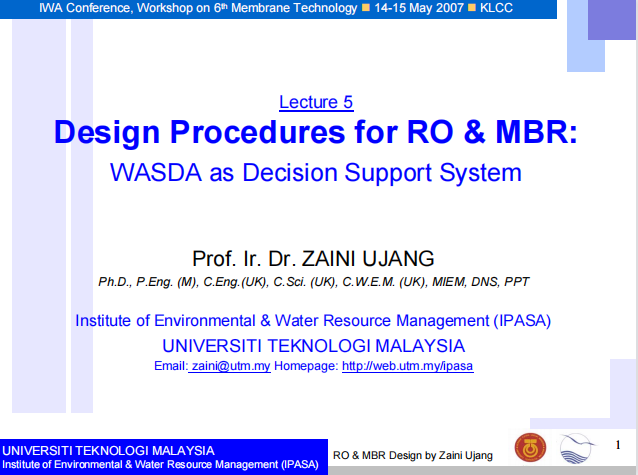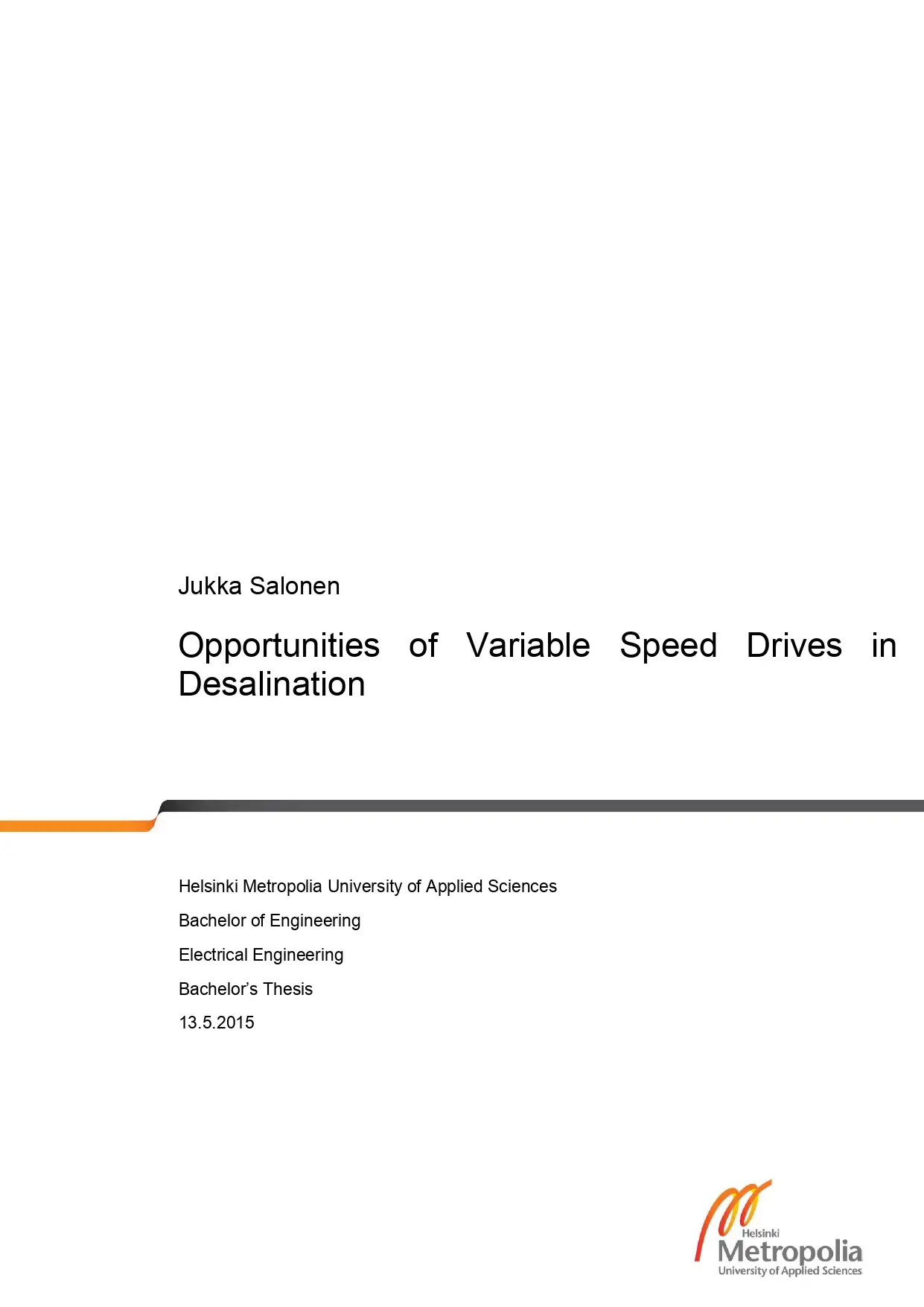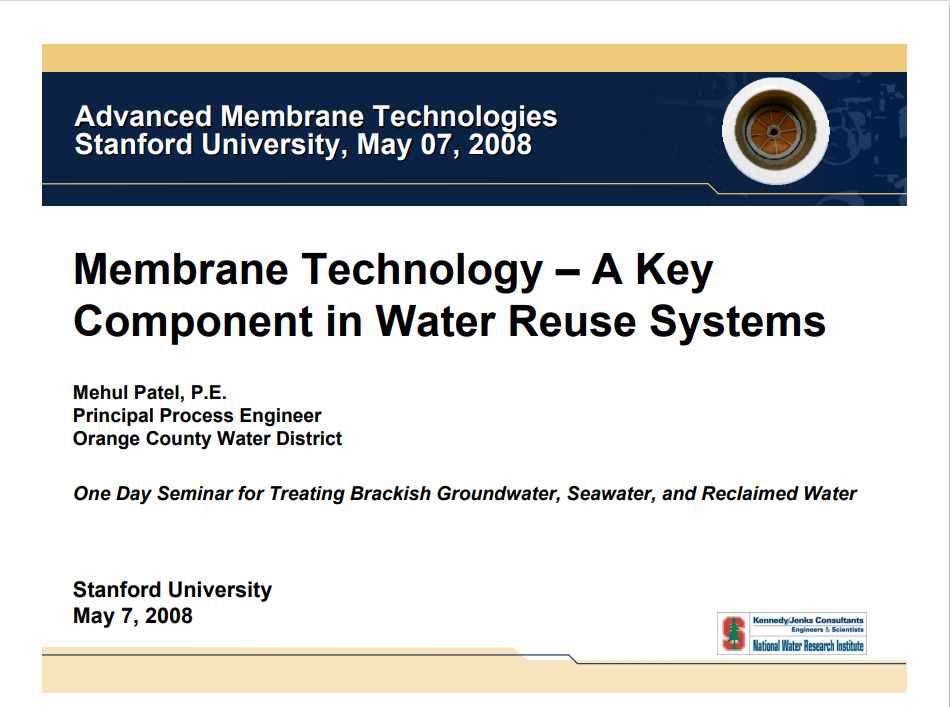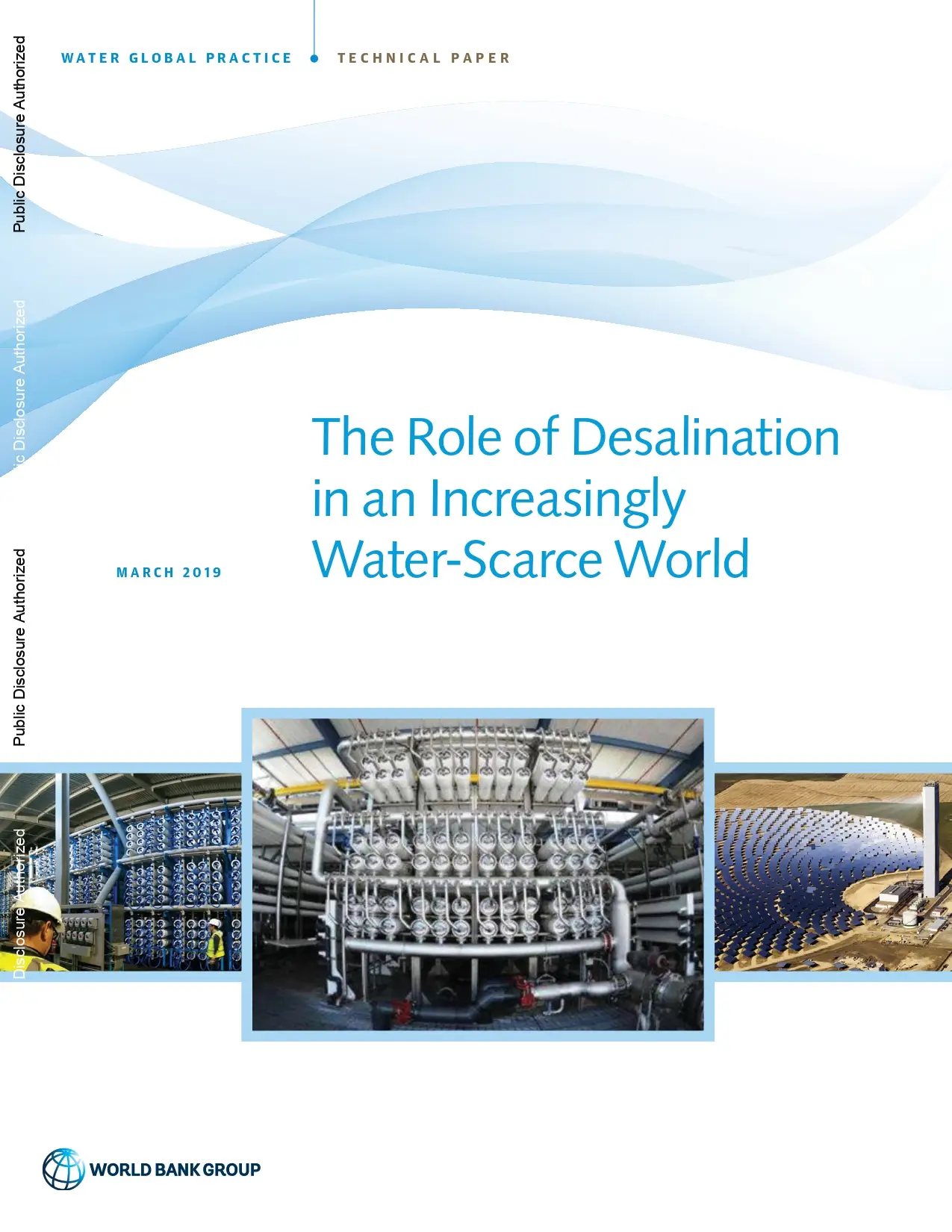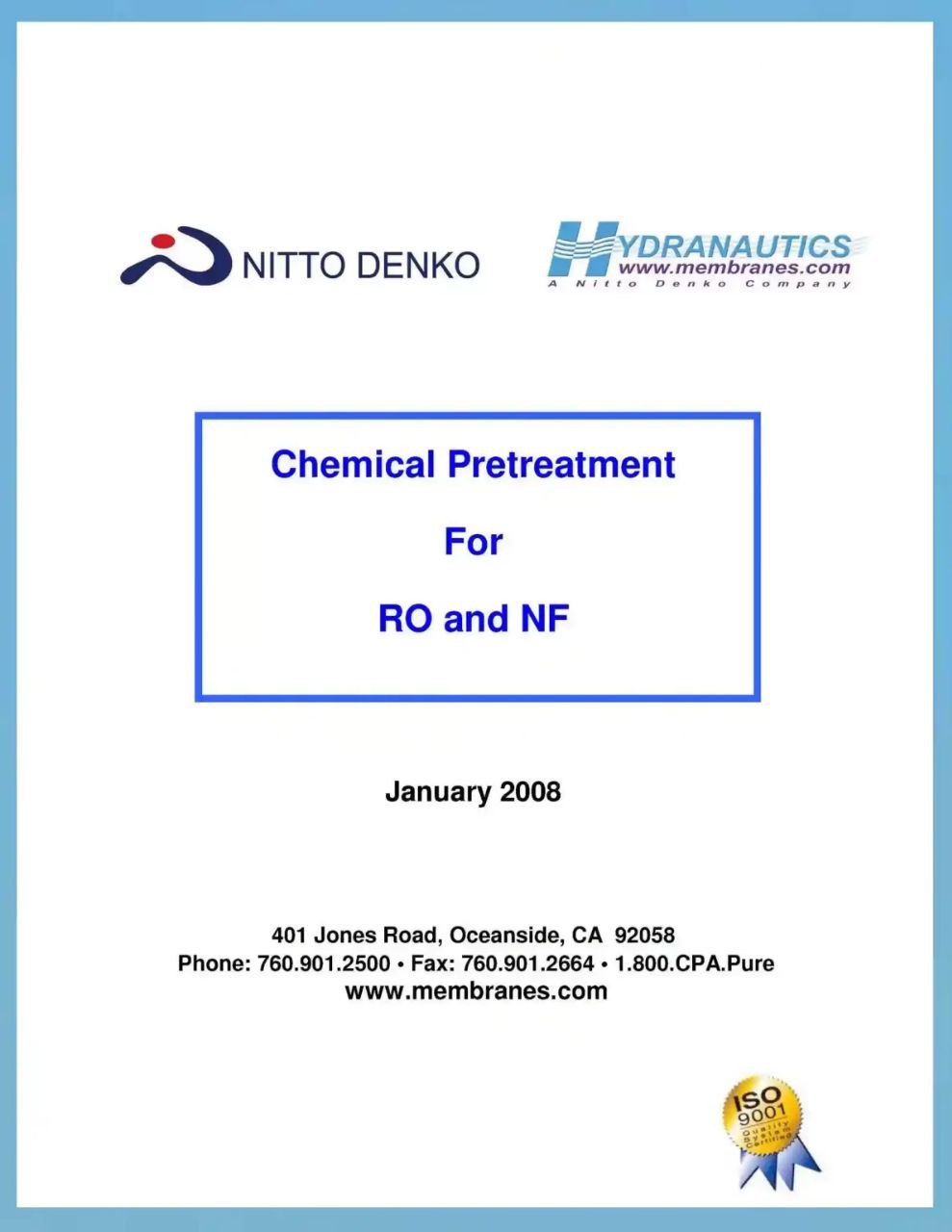Physical Conditioning For Scale Prevention During Desalination By Reverse Osmosis
Abstract
Desalination by reverse osmosis (RO) is the favoured method for potable water production from seawater. However, the membranes are subject to fouling by scaling species, principally calcium carbonate, which reduce the operating flux. Traditionally this scale has been controlled by the addition of chemicals to the system which are effective but add to the chemical load in the waste stream and so having a detrimental impact on the environment. Candidate non-chemical methods for enhancing desalination by reverse osmosis choose the application of external magnetic or electromagnetic fields (Baker and Judd, 1996; Baker et al., 1997; Lipus, 2001). These so-called physical conditioning methods are highly contentious, and have never been satisfactorily proven. It has also been suggested that these methods can be enhanced by using a “distribution plate”, which is claimed to work by inducing cavitations. This is the basis of the Grahamtek system (Grahamtek et al. 1997), and it is this system that formed the basis of the study. The objective of the study was to assess the impact of the two conditioning methods, based on a flow distribution plate coupled with electromagnetic scale mitigation, during desalination by RO primarily with respect to membrane permeability. Three different feed waters, deionized water, salt water and hardened saline water, have been investigated and the impacts studied included both desalination performance, based on membrane permeability, and retentate water quality. In addition, various side experiments were conducted, and these included a “rapid scaling test”, developed in-house to study calcium carbonate precipitation. No impact of conditioning on either deionized or saline water was evident on the application of both physical conditioning and the distribution plate, either synergistically or in isolation. Some data from the side experiments indicated possible impacts of physical conditioning on scaling of hardened saline water. These included crystal shape and size of the calcium carbonate, retentate pH and conductivity, particle zeta potential and the rapid scaling test transient. However, the limited number of measurements performed meant that these changes could not be regarded as statistically significant and performance of the RO process itself was unaltered by physical conditioning. Key words: scale, reverse osmosis, calcium carbonate, desalination, physical conditioning, permeability, distribution plate
Physical Conditioning For Scale Prevention During Desalination By Reverse Osmosis
Abstract
Desalination by reverse osmosis (RO) is the favoured method for potable water production from seawater. However, the membranes are subject to fouling by scaling species, principally calcium carbonate, which reduce the operating flux. Traditionally this scale has been controlled by the addition of chemicals to the system which are effective but add to the chemical load in the waste stream and so having a detrimental impact on the environment. Candidate non-chemical methods for enhancing desalination by reverse osmosis choose the application of external magnetic or electromagnetic fields (Baker and Judd, 1996; Baker et al., 1997; Lipus, 2001). These so-called physical conditioning methods are highly contentious, and have never been satisfactorily proven. It has also been suggested that these methods can be enhanced by using a “distribution plate”, which is claimed to work by inducing cavitations. This is the basis of the Grahamtek system (Grahamtek et al. 1997), and it is this system that formed the basis of the study. The objective of the study was to assess the impact of the two conditioning methods, based on a flow distribution plate coupled with electromagnetic scale mitigation, during desalination by RO primarily with respect to membrane permeability. Three different feed waters, deionized water, salt water and hardened saline water, have been investigated and the impacts studied included both desalination performance, based on membrane permeability, and retentate water quality. In addition, various side experiments were conducted, and these included a “rapid scaling test”, developed in-house to study calcium carbonate precipitation. No impact of conditioning on either deionized or saline water was evident on the application of both physical conditioning and the distribution plate, either synergistically or in isolation. Some data from the side experiments indicated possible impacts of physical conditioning on scaling of hardened saline water. These included crystal shape and size of the calcium carbonate, retentate pH and conductivity, particle zeta potential and the rapid scaling test transient. However, the limited number of measurements performed meant that these changes could not be regarded as statistically significant and performance of the RO process itself was unaltered by physical conditioning. Key words: scale, reverse osmosis, calcium carbonate, desalination, physical conditioning, permeability, distribution plate
Photovoltaic Reverse Osmosis Desalination System
Abstract:
An energy efficient, cost competitive, modular, small-scale photovoltaic reverse osmosis (PVRO) desalination system has been developed and field tested. This PVRO system will fit the needs of off-power-grid communities that face drinking water shortages due to saline water problems. The system is powered directly by a photovoltaic (PV) array, without an inverter or battery. A variable-flow pump was utilized to compensate for the variable power output due to daily and seasonal solar intensity fluctuations. To ensure efficient system operation, a linear current booster or maximum power point tracker was used to match power available with load requirements. A solid state circuit was designed to detect a suitable power level set by the user and to activate a membrane rinsing cycle prior to shutdown. The PVRO system was field tested for 3 months in Mesquite, Nevada. The PVRO system performed well overall, consistently desalinating water at Mesquite, which has a salinity of 3,500 parts per million (ppm) total dissolved solids (TDS), to water of 100 ppm TDS. During the field test, energy use per volume of water produced was 1.38 kilowatt-hours per cubic meter, which is low for a small system.
Photovoltaic Reverse Osmosis Desalination System
Abstract:
An energy efficient, cost competitive, modular, small-scale photovoltaic reverse osmosis (PVRO) desalination system has been developed and field tested. This PVRO system will fit the needs of off-power-grid communities that face drinking water shortages due to saline water problems. The system is powered directly by a photovoltaic (PV) array, without an inverter or battery. A variable-flow pump was utilized to compensate for the variable power output due to daily and seasonal solar intensity fluctuations. To ensure efficient system operation, a linear current booster or maximum power point tracker was used to match power available with load requirements. A solid state circuit was designed to detect a suitable power level set by the user and to activate a membrane rinsing cycle prior to shutdown. The PVRO system was field tested for 3 months in Mesquite, Nevada. The PVRO system performed well overall, consistently desalinating water at Mesquite, which has a salinity of 3,500 parts per million (ppm) total dissolved solids (TDS), to water of 100 ppm TDS. During the field test, energy use per volume of water produced was 1.38 kilowatt-hours per cubic meter, which is low for a small system.
Overview Of Desalination Plant Intake Alternatives
Introduction:
Over 75 % of the US population lives along the coast. Currently, many of our coastal communities are supplied by inland fresh water resources or low-salinity coastal aquifers. Because of the limited availability of these resources and their intensive use over the years, traditional sources of water supply are nearing depletion in many parts of the country, and reliance solely on such resources is no longer sustainable in the long run. Along with enhanced water reuse and conservation, seawater and brackish desalination provides a viable alternative for securing reliable and drought-proof water supplies for coastal communities. The purpose of desalination plant intakes is to collect source seawater of adequate quantity and quality in a reliable and sustainable fashion so as to produce desalinated water cost-effectively and with minimal impact on the environment. Currently, there are two categories of widely used desalination plant source water collection facilities: open intakes and subsurface intakes (wells and infiltration galleries). Open intakes collect seawater directly from the ocean via on-shore or off-shore inlet structure and pipeline interconnecting this structure to the desalination plant. Subsurface intakes, such as vertical beach wells, horizontal wells, slant wells and infiltration galleries, tap into the saline or brackish coastal aquifer and/or the off-shore aquifer under the
ocean floor. This white paper presents an overview of alternative open-ocean and subsurface intake technologies for seawater desalination plants. While subsurface intakes (beach wells, infiltration galleries, slant wells, etc.) are often favored by the environmental community because of their potentially lower impingement and entrainment impacts on aquatic life, they have found limited application to date, especially in medium- and large-scale desalination projects. The white paper describes the main challenges associated with the use of subsurface intakes and discusses the key factors that determine their feasibility for the site specific conditions of a given desalination project. Potential impingement and entrainment (I&E) impacts associated with the operation of open ocean intakes for seawater desalination plants are discussed in a separate Water Reuse Association white paper entitled “Desalination Plant Intakes – Impingement and Entrainment Impacts and Solutions.”
Overview Of Desalination Plant Intake Alternatives
Introduction:
Over 75 % of the US population lives along the coast. Currently, many of our coastal communities are supplied by inland fresh water resources or low-salinity coastal aquifers. Because of the limited availability of these resources and their intensive use over the years, traditional sources of water supply are nearing depletion in many parts of the country, and reliance solely on such resources is no longer sustainable in the long run. Along with enhanced water reuse and conservation, seawater and brackish desalination provides a viable alternative for securing reliable and drought-proof water supplies for coastal communities. The purpose of desalination plant intakes is to collect source seawater of adequate quantity and quality in a reliable and sustainable fashion so as to produce desalinated water cost-effectively and with minimal impact on the environment. Currently, there are two categories of widely used desalination plant source water collection facilities: open intakes and subsurface intakes (wells and infiltration galleries). Open intakes collect seawater directly from the ocean via on-shore or off-shore inlet structure and pipeline interconnecting this structure to the desalination plant. Subsurface intakes, such as vertical beach wells, horizontal wells, slant wells and infiltration galleries, tap into the saline or brackish coastal aquifer and/or the off-shore aquifer under the
ocean floor. This white paper presents an overview of alternative open-ocean and subsurface intake technologies for seawater desalination plants. While subsurface intakes (beach wells, infiltration galleries, slant wells, etc.) are often favored by the environmental community because of their potentially lower impingement and entrainment impacts on aquatic life, they have found limited application to date, especially in medium- and large-scale desalination projects. The white paper describes the main challenges associated with the use of subsurface intakes and discusses the key factors that determine their feasibility for the site specific conditions of a given desalination project. Potential impingement and entrainment (I&E) impacts associated with the operation of open ocean intakes for seawater desalination plants are discussed in a separate Water Reuse Association white paper entitled “Desalination Plant Intakes – Impingement and Entrainment Impacts and Solutions.”
Overcoming Operating Pressure Barrier In High Recovery Membrane Desalination Via Hybrid RO-NF Processes
Abstract:
This Desalination and Water Purification Research Program (DWPR) research project investigated whether hybrid reverse osmosis-nanofiltration (RO-NF) processes might have lower pressure requirements for high recovery desalination than conventional RO processes. We evaluated the operating pressure requirements and concentrate volume reduction in high recovery desalination at a theoretical and bench-scale testing level. We modeled three hybrid RO-NF processes and one conventional RO process. The project found that modeled hybrid RO-NF processes can operate at significantly lower pressure requirements and, consequently, at higher water recovery levels than conventional RO processes, while meeting the same target product water quality. Bench-scale experimental data confirmed the expected reduction in pressure requirements, albeit at suboptimal energy requirements (as the commercial NF membrane had suboptimal NF TDS rejection). The project demonstrated that NF TDS rejection is a critical parameter governing both operating pressure and energy consumption. The present study suggests that further evaluation of single-stage RO-NF operation at pressure-optimal NF rejection (70 - 80%) has merit. Next recommended steps are to investigate the hybrid processes ability to address challenges within feedwater, variable feedwater, and mineral scaling, as well as to explore the benefits of using energy recovery devices.
Overcoming Operating Pressure Barrier In High Recovery Membrane Desalination Via Hybrid RO-NF Processes
Abstract:
This Desalination and Water Purification Research Program (DWPR) research project investigated whether hybrid reverse osmosis-nanofiltration (RO-NF) processes might have lower pressure requirements for high recovery desalination than conventional RO processes. We evaluated the operating pressure requirements and concentrate volume reduction in high recovery desalination at a theoretical and bench-scale testing level. We modeled three hybrid RO-NF processes and one conventional RO process. The project found that modeled hybrid RO-NF processes can operate at significantly lower pressure requirements and, consequently, at higher water recovery levels than conventional RO processes, while meeting the same target product water quality. Bench-scale experimental data confirmed the expected reduction in pressure requirements, albeit at suboptimal energy requirements (as the commercial NF membrane had suboptimal NF TDS rejection). The project demonstrated that NF TDS rejection is a critical parameter governing both operating pressure and energy consumption. The present study suggests that further evaluation of single-stage RO-NF operation at pressure-optimal NF rejection (70 - 80%) has merit. Next recommended steps are to investigate the hybrid processes ability to address challenges within feedwater, variable feedwater, and mineral scaling, as well as to explore the benefits of using energy recovery devices.
Optimizing Scale Inhibition Costs In Reverse Osmosis Desalination Plants
Abstract:
Over the last few decades, advancements in technology and engineering design have allowed for the construction of reverse osmosis (RO) plants with increased production capacities that could operate at reasonable energy costs. Yet the portion of the operating cost related to consumable scale inhibition chemicals has not changed dramatically due to the disregard by the water treatment community for emerging scale inhibition technologies. The result has been the consumption of enormous quantities of sulfuric acid unnecessarily increasing pretreatment, post-treatment and brine disposal costs. A water district in suburbs of Los Angeles, California has recently completed the construction of a
265,000 m3 /day MF/RO plant for wastewater reuse. Based on 30 years of experience operating a 19,000 m3 /day MF/R.O. plant, the district took a novel approach to reducing the cost of consumable scale inhibition chemicals. A competitive bid was issued which took into account feed pH in addition to cost and dosage of antiscalant.1 The feed pH was used to calculate an acid dosage rate and the annual cost of sulfuric acid use for pH reduction. This was then combined with the annual cost of the antiscalant in order to select the most cost effective treatment as offered by the various antiscalant manufacturers participating in the bid. The selected treatment was then piloted for 50 days to verify its performance at the dosage and feed pH claimed by the manufacturer.
Optimizing Scale Inhibition Costs In Reverse Osmosis Desalination Plants
Abstract:
Over the last few decades, advancements in technology and engineering design have allowed for the construction of reverse osmosis (RO) plants with increased production capacities that could operate at reasonable energy costs. Yet the portion of the operating cost related to consumable scale inhibition chemicals has not changed dramatically due to the disregard by the water treatment community for emerging scale inhibition technologies. The result has been the consumption of enormous quantities of sulfuric acid unnecessarily increasing pretreatment, post-treatment and brine disposal costs. A water district in suburbs of Los Angeles, California has recently completed the construction of a
265,000 m3 /day MF/RO plant for wastewater reuse. Based on 30 years of experience operating a 19,000 m3 /day MF/R.O. plant, the district took a novel approach to reducing the cost of consumable scale inhibition chemicals. A competitive bid was issued which took into account feed pH in addition to cost and dosage of antiscalant.1 The feed pH was used to calculate an acid dosage rate and the annual cost of sulfuric acid use for pH reduction. This was then combined with the annual cost of the antiscalant in order to select the most cost effective treatment as offered by the various antiscalant manufacturers participating in the bid. The selected treatment was then piloted for 50 days to verify its performance at the dosage and feed pH claimed by the manufacturer.
Opportunities Of Variable Speed Drives In Desalination
Introduction
Approximately 97% of the world's water supplies are seawater. Of the remaining fresh water, a mere 1% is actually available for us to use for drinking and irrigation. As global fresh water resources are also very unevenly distributed, over 40% of the world's population lives in areas with limited access to water supplies. Moreover, it is estimated that access to water will only become more difficult, as the global population will continue to grow and the global demand for water will continue to grow even faster. Both developed and developing countries are facing water scarcity issues. For these reasons, it is vital to search for methods that can be used to turn seawater into fresh water.
Opportunities Of Variable Speed Drives In Desalination
Introduction
Approximately 97% of the world's water supplies are seawater. Of the remaining fresh water, a mere 1% is actually available for us to use for drinking and irrigation. As global fresh water resources are also very unevenly distributed, over 40% of the world's population lives in areas with limited access to water supplies. Moreover, it is estimated that access to water will only become more difficult, as the global population will continue to grow and the global demand for water will continue to grow even faster. Both developed and developing countries are facing water scarcity issues. For these reasons, it is vital to search for methods that can be used to turn seawater into fresh water.
Zero Liquid Discharge-Desalination
Achieving strict wastewater treatment regulations and “reducing water usage have become one of the most critical considerations in industry today. Numerous environmental regulations, rigorous permitting processes, and lack of water availability, among other factors, are driving many industrial facilities to implement zero liquid discharge (ZLD) systems as a solution”. Zero Liquid Discharge (ZLD) technologies help to achieve environmental
compliance, reduce carbon footprint, create positive public perception, and recover high purity water for reuse. This source guide is prepared for the Workshop on “Zero Liquid Discharge Desalination” which will be held during October 18-19, 2011 by Water Resources Division at Kuwait Institute for Scientific Research. The guide covers the latest studies conducted on the theme of the workshop. Information in the bibliographic section has been taken from Scopus database.
Zero Liquid Discharge-Desalination
Achieving strict wastewater treatment regulations and “reducing water usage have become one of the most critical considerations in industry today. Numerous environmental regulations, rigorous permitting processes, and lack of water availability, among other factors, are driving many industrial facilities to implement zero liquid discharge (ZLD) systems as a solution”. Zero Liquid Discharge (ZLD) technologies help to achieve environmental
compliance, reduce carbon footprint, create positive public perception, and recover high purity water for reuse. This source guide is prepared for the Workshop on “Zero Liquid Discharge Desalination” which will be held during October 18-19, 2011 by Water Resources Division at Kuwait Institute for Scientific Research. The guide covers the latest studies conducted on the theme of the workshop. Information in the bibliographic section has been taken from Scopus database.
Cost Determination & Designing of Desalination Plant
Water sector is considered to be one of the main sectors which communities development and growth depends on. Specially water plays an important role in the fields of comprehensive development. In addition that water remains to be the first element of life and the element of food, industrial, and economic security. it was necessary to search into the non-traditional sources of water , because of the real case of water in Jordan and the imbalance equation between demand and availability and the high percentage of water deficit where the percentage almost equal 500 million cubic meter yearly. Where non traditional sources includes water desalination and the reuse of waste water. since the desalination of water is the only choice for deficit reduction and use
desalinated water in drinking purposes we had to search in water desalination subject. Where water desalination will be the solution for water deficit.
It’s expected that researches and projects related to water will be the main motivation to accelerate the reliance on desalination and remove the consequences which may cause by the application of desalination projects. And in this project the attention were to the design of treatment plants with high efficiency and low costs.
Cost Determination & Designing of Desalination Plant
Water sector is considered to be one of the main sectors which communities development and growth depends on. Specially water plays an important role in the fields of comprehensive development. In addition that water remains to be the first element of life and the element of food, industrial, and economic security. it was necessary to search into the non-traditional sources of water , because of the real case of water in Jordan and the imbalance equation between demand and availability and the high percentage of water deficit where the percentage almost equal 500 million cubic meter yearly. Where non traditional sources includes water desalination and the reuse of waste water. since the desalination of water is the only choice for deficit reduction and use
desalinated water in drinking purposes we had to search in water desalination subject. Where water desalination will be the solution for water deficit.
It’s expected that researches and projects related to water will be the main motivation to accelerate the reliance on desalination and remove the consequences which may cause by the application of desalination projects. And in this project the attention were to the design of treatment plants with high efficiency and low costs.
Chemical Pretreatment For RO and NF
There are a number of chemicals that can be introduced into the RO feed to enhance the
There are a number of chemicals that can be introduced into the RO feed to enhance the operation of the RO system.
· Acids
· Caustic
· Dechlorination Chemicals
· Antiscalants and Dispersants
Chemical Pretreatment For RO and NF
There are a number of chemicals that can be introduced into the RO feed to enhance the
There are a number of chemicals that can be introduced into the RO feed to enhance the operation of the RO system.
· Acids
· Caustic
· Dechlorination Chemicals
· Antiscalants and Dispersants
Desalination, Trends and Technologies
Preface:
The sustainability and prosperity of the ancient civilizations of China, Egypt, Babylonia, Phoenicia, Persia and Roma were based on the extensive use of water for human consumption, crop irrigation, canal navigation and energy generation. Today, the worldwide scarcity of water and clean energy constitutes a central and critical problem for the whole humankind. This situation is aggravated as industrial, agricultural and municipal effluents reach the water bodies, or the coastal seawater that is used as feed for desalination plants. All these problems are linked to the actual, natural and anthropogenic changes of climate, global warming and greenhouse-gas emissions, all interrelated phenomena that affect our planet. In order to avoid damage to its facilities and equipment, the desalination industry invests considerable efforts to deal with these changes, in particular with extreme events such as torrential rains, devastating FL floods, dry seasons with devouring fifers, as well as with extended spells of cold weather with freezing temperatures. The book chapters are arranged in an hierarchical sequence, starting with conventional and novel desalination processes and following with energy, environmental, economic and ecological issues, all affecting the desalination industry image and profitability. Leading experts from academia and industry, as well as environment researchers, distinguished teachers and experienced engineers have writ en special chapters for this impressive collection. The contributing authors offer a large amount of practical information, presenting it in a highly condensed yet coherent body of useful knowledge and practical expertise. Moreover, the multi-authored characteristic of this volume offers a wide spectrum of knowledge and experience, as the authors are specialists in different fields and express diverse approaches and orientations. The intended multifacet content of this publication certainly contributes to enrich it. This compendium provides valuable, encyclopedic knowledge on research, development, processes, plants and technologies of this industry, from the fundamental concepts up to many practical cases collected from around the world. Hence, it provides a useful insight into the world of water, energy and desalination, easy to follow and to apply. This volume is an essential companion to chemists, as well as to civil and chemical engineers who design, build and operate desalination plants. It is also highly relevant to maintenance personnel, corrosion specialists, material- and mechanical engineers.
Desalination, Trends and Technologies
Preface:
The sustainability and prosperity of the ancient civilizations of China, Egypt, Babylonia, Phoenicia, Persia and Roma were based on the extensive use of water for human consumption, crop irrigation, canal navigation and energy generation. Today, the worldwide scarcity of water and clean energy constitutes a central and critical problem for the whole humankind. This situation is aggravated as industrial, agricultural and municipal effluents reach the water bodies, or the coastal seawater that is used as feed for desalination plants. All these problems are linked to the actual, natural and anthropogenic changes of climate, global warming and greenhouse-gas emissions, all interrelated phenomena that affect our planet. In order to avoid damage to its facilities and equipment, the desalination industry invests considerable efforts to deal with these changes, in particular with extreme events such as torrential rains, devastating FL floods, dry seasons with devouring fifers, as well as with extended spells of cold weather with freezing temperatures. The book chapters are arranged in an hierarchical sequence, starting with conventional and novel desalination processes and following with energy, environmental, economic and ecological issues, all affecting the desalination industry image and profitability. Leading experts from academia and industry, as well as environment researchers, distinguished teachers and experienced engineers have writ en special chapters for this impressive collection. The contributing authors offer a large amount of practical information, presenting it in a highly condensed yet coherent body of useful knowledge and practical expertise. Moreover, the multi-authored characteristic of this volume offers a wide spectrum of knowledge and experience, as the authors are specialists in different fields and express diverse approaches and orientations. The intended multifacet content of this publication certainly contributes to enrich it. This compendium provides valuable, encyclopedic knowledge on research, development, processes, plants and technologies of this industry, from the fundamental concepts up to many practical cases collected from around the world. Hence, it provides a useful insight into the world of water, energy and desalination, easy to follow and to apply. This volume is an essential companion to chemists, as well as to civil and chemical engineers who design, build and operate desalination plants. It is also highly relevant to maintenance personnel, corrosion specialists, material- and mechanical engineers.


